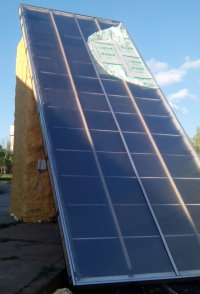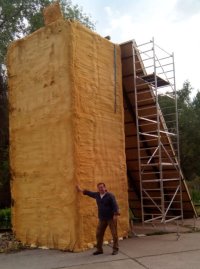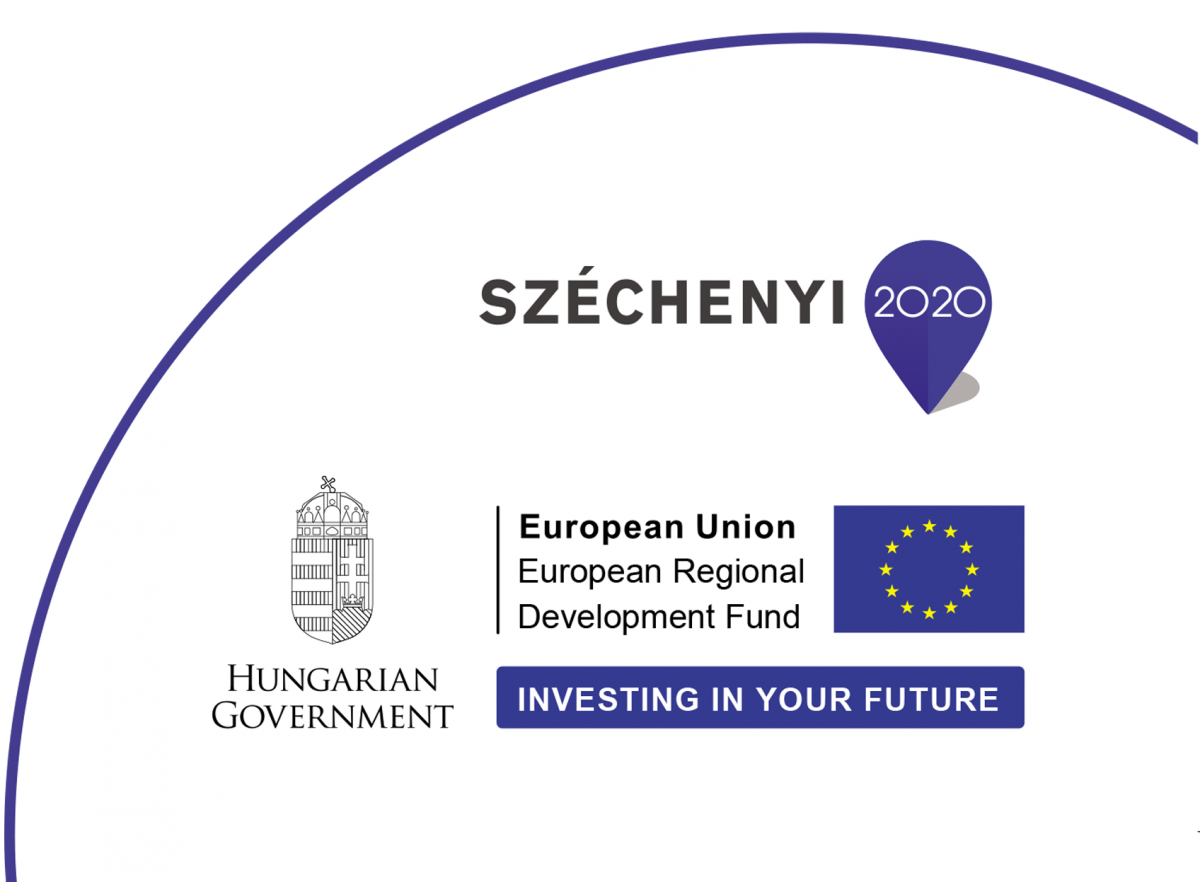GET – Green Enegy Tower
Definition
Device to collect and store solar energy and optionally to generate electricity, suitable for cost-effective manufacturing in series.
1. Basic data
The annual energy demand of an average Hungarian family house (detached house) is 15,000kWh, of which around 11,000kWh is needed for the heating system, 2,000kWh for domestic hot water production and 2,000kWh for the operation of electrical devices. This implies EUR 1300-2000 expenditure per family house, depending on the method of heating, and with significant differences within the European Union. In the South Italian, Greek and Spanish region, for example, there is practically no heating, but more energy is used for air conditioning. In the northern countries, on the other hand, the number sunshine hours is considerably lower, so less energy can be collected and longer buffer periods are needed. GET intended for the northern region would have to be supplied with much larger collector surfaces.
Green energy might well offer the best solution for easing the energy dependence of the private/family sector in the rural regions, but to date, such systems have a rather narrow range of “usability”. Since green energy is characterized by low density and its generation and use do not coincide in space and time, such energy is to be stored somehow.
The energy of 15,000kWh corresponds to the quantity of energy coming from the Sun onto ~7m2 of the surface of the Earth annually. To collect that quantity by a photovoltaic system characterized by an optimal 10% efficiency, a system surface of around 70m2 would be needed. With solar collectors of 50% efficiency, it would be sufficient to have 14m2.
“Domestically” produced green energy, however, must be used immediately due to the lack of high-capacity energy storage facilities. (In several countries, surplus green energy can be fed to a network, and it is purchased (on a compulsory basis) by the service provider, but elsewhere and in particular in the developing countries, no such arrangements exist as yet.)
2. Is the green energy potential of a single family house sufficient to ensure energy self-sufficiency?
Wind energy
In Hungary, the average wind velocity is 3.4 m/s and the relevant energy content per 1 m2 is 1 kWh/day. Therefore, a wind power machine with a surface of at least 50 m2 (i.e. a diameter of more than 8 m plus the base) would be needed to cover the energy demand of a family house this way, and that is too expensive for a household and it would be impossible to install it at some places.
Solar energy
The number of sunshine hours is 2,200h/year, and the power density of solar energy is approximately 1 kW/m2. That is, at annual level, 2,200kWh of green energy could be “collected” per m2. In other words, the energy demand of an average family house corresponds to solar energy radiated on ~7m2. The efficiency of an average solar panel is 7-10%, so at least 70m2 would be needed to collect 15,000kWh.
Why don’t we use solar energy for heating?
- 80% of solar energy arrives in the summer, whereas heating is needed in wintertime.
- A low-loss, high-capacity heat storage system is needed.
- Even the best solar energy collector devices operate with less than 100% efficiency.
3. Design of the GET product
GET could also be called a “micro CHP system”, CHP being a well-known term in Western Europe for “combined heat and power” systems of this type.
GET comprises two major components. One is a 30 m3 hot water storage tank made of a 20’ standard container that is set on its smaller side. Solar energy is used to heat the water in the tank, and hence we can store 2000 kWh thermal energy. Storage loss obviously depends on the quality of the thermal insulation; for GET, we have managed to reduce that to 0.15 W/m2K. The other main component is a solar collector of 24 m2 developed by ourselves.
The standard 20’ container is covered with a sprayed polyurethane foam layer of 10cm thickness. Two high-capacity heat exchangers are installed inside the container, of which one circuit provides domestic hot water and the other hot water needed for heating.
The tank and the heat exchanger are interconnected by 2”-insulated pipes and circulation is ensured by a circulating pump controlling circulation. The pumps are controlled by a microcomputer, based on the heat output and the exit points of the collectors, that can be linked, if need be, to any smart home control system.
The heat collector/heat storage part of the system is open, to prevent excessive steam pressure increase due to overheating.

b., Heat collector, southern side

a, The GET tank with the inventor
Optionally, GET can be made suitable for generating electricity by installing a Stirling engine on top of the hot water tank. The hot side of the Stirling engine is heated to right above 90 °C with the hot branch of the solar collector, and its cold branch is air-cooled.
4. Characteristics of the energy tower
Dimensions and characteristics of GET
| – Installation area: | 3m x 9m |
| – Container size (insulated): | 2.7m x 2.7m x 6m |
| – Heat collector size (fixed to the container at an angle of 45°): | 3m x 8m |
Other characteristics:
- closed dual circulation and heat exchanger system
- insulation: k = 0.15 W/m2K heat loss
- long useful life (15-20 years)
Energy data under Hungarian conditions: (in countries with different climate conditions, the dimensioning is to be altered; the product will have to be manufactured in several versions)
| – max. heat energy collected: | 31.680 kWh/year |
| – power generation: | 3.000kWh (240V/50Hz) |
| – thermal energy production: | 28.680kWh (heating and domestic hot water) |
The quantity of energy that can be collected this way corresponds to almost twice the quantity needed by an average family house. The GET system is sized so as to provide the house heating and domestic hot water even if half of the energy is lost at the annual level.
5. Advantages of GET relative to the rival green energy collector and storage devices
The main advantage of GET is that it provides for heat collection + storage + power generation within one and the same device. Systems of similar capacities could be assembled of rival devices, but they would be much more expensive.
The 30 m3 hot water storage capacity is outstanding: it has no rival today in the market. It is suitable for the storage of even 2,000kWh usable heat. The highest-capacity heat storage device available in the market generates 120kWh, and its price exceeds EUR 2,000.
The only disadvantage of the large-size storage device is that it occupies the area specified above.
On the other hand, it is an advantage of our heat collector device that it collects solar energy on a surface of 24 m2, it is constructed of easy-to-mount standard parts and hence it is also easy to repair. Its price per 1 m2 is less than EUR 133, whereas the cheapest sun collectors are sold for at least for EUR 200-266/m2 in Hungary.
6. Targeted market segments, clients and geographical markets
It will be particularly important in the 21st century to ensure the supply of energy while reducing dependence, increasing the share of green energy and preventing any increase in the inertia problems of networks. This is why our company focuses on technologies to develop the renewable sources of energy, to enhance production efficiency and expand the possibilities of storing green energy. Our products are intended for clients made sensitive by their high energy awareness or receptive due to their environmental conditions.
We consider the current market actors and their products our rivals only in the sense that we will produce more efficient products suitable for more extensive use, representing technologically more advanced and more cost-effective products than those that are commonly known today.
In Phase 1, our primary target market will be that of isolated (sporadic)
- residential properties (detached family houses, villas, manors);
- weekend houses and, moreover,
- minor agricultural units (homesteads, farms) or
- tourist facilities (boarding houses, minor hotels).
7. Technological preparedness, novelty
Proof-of-concept (PoC) – time and cost analysis. We constructed the model of the GET concept and the test run is underway.
Ample experience has been accumulated during the development phase regarding the design of the tank, the order of the insulating layers and the operational solutions. In terms of cost-effectiveness, the technology fulfilled the expectations. The collector system outperformed in several respects during the tests.
The experiments are in progress; we are currently at Technology Readiness Level 6. They will be followed by the product sales activities, to optimise the production operations, e.g. cleaning, design of holes, welding, painting, insulation etc. as well as the materials to be used. During the tests, the container walls were braced by a 40*80 mm hollow section, but angles of 80mm will be sufficient for manufacturing.
GET is a novel solution is several respects:
It aims at full-scale energy supply from the start, whereas the rival solar-energy-based solutions are meant to provide a supplementary, additional supply of energy.
It can be repaired, mounted and recycled
Instead of high-tech materials, it is made of materials that can be procured in a cost-effective way anywhere
We develop a complex system that can be connected to other green energy technologies or to conventional energy systems.

